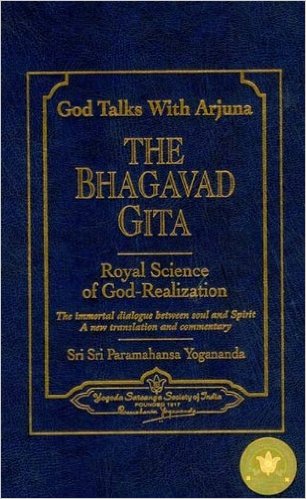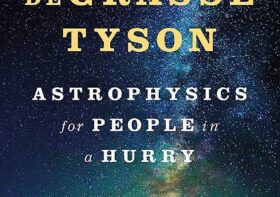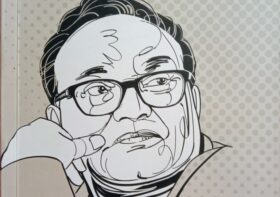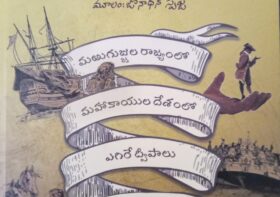God Talks with Arjuna – Vols 1 & 2

Written by: Raghavendra Bethamcharla
**********
God Talks with Arjuna – Vols 1 & 2
By Paramahamsa Yogananda
An introduction by a Sadhaka.
An autobiography of a Yogi might be the best known and widely known work of Yoganandji but I find the geeta bhashya he did in God Talks with Arjuna the better of the two works. Atleast for a Sadhaka. May be it was very appropriate that Dad introduced me to The Autobiography of a Yogi around 20 years back when the story telling and Anecdotes were an “Interesting way” to introduce the spiritual journey, though my journey did not start with this introduction. May be it is very appropriate that I searched for and bought the two volumes of the geeta bhashya, as a sadhaka at this stage.
I have not yet read the two volumes completely yet. Hence this is just an introduction. It will take me years probably to finish the first reading. Then, may be, I will write what I could “understand” and implement.
The first thing that stuck me about this work, as soon as I read the first twenty pages of the first volume was…….this is a work of a sadhaka. I don’t know, but I did not get this when I skimmed Sankara bhaashya and Raamanuja Bhashyas. I felt “ah, a book written for the practials… for a sadhaka, by a sadhaka who tread this path”.
Let me explain a little bit. When you are in this spiritual journey with nothing but the prompts and nudges of life as a motivation and just the innate acceptance that life should be led by truth and not knowing why it should be led by truth and for the moment rationalising that “karanam, karanam, karta, vikarta, kriya, phalam” etc will become eventually clear or eventually unimportant, the journey becomes difficult. But then sadhana is “tapah”, to burn!!!
And this journey becomes a journey full of mysteries to be searched out. Why am I in this path when I do not believe any afterlives and when, for the moment the individuation of universal consciousness appears to be a rational idea but nothing more than that? Why does it appeal more to me when the current sadhana “appears” to be more onerous then the everlasting truthful conscious bliss (sat chit Ananda) that it seems will be at the end of the rainbow? Etc etc. For the moment these existential queries appear to be …… mysteries!!!
But then you accept the premise that “All will be revealed when you get the experiential wisdom” and leave it at that. BUT, some practical questions haunt every step. If this samsaara is a maaya, then what actions need to be done, at this point of time? If dharma, adharma, nyaya anyaya, right and wrong are all individually defined by billions of consciousnesses (and unconsciousnesses too they say) thus immediately negating their permanence, then on what should daily life actions be based? What should I do from awakening in the morning to sleeping at night and from night to dawn?
It is the answers to these kind of “small” things that stuck me with awe in these God Talks with Arjuna two volumes. In these two books, Yoganandji comments or interprets the Bhagavatgita from a Sadhaka’s point of view, COMPLETELY. Usually people say Geeta is about karmayoga. BUT, in practice I found that none of the classical four types of yoga are independent of each other, atleast to a sadhaka. And Yoganandji, interprets geeta in a similar way. He does not are weather his interpretation is entering the domain of gnaana yoga or leaving the remits of karma yoga or impinging on the boundaries of bhakti yoga etc..damn be all you man made boundaries, I seek only the brahman and so shall I go forward irrespective of any artificial boundaries…..so seems to say Yoganandji in his interpretation. And goes on to give the interpretations in such a way that the sadhaka’s everyday obstacles are answered, his doubts cleared, his way smoothened a little bit.
For example, he says dutiful actions and meditative actions are the only actions to be taken up by a sadhaka. How wonderful!!! And such a simple solution to the daily turmoil. What am I supposed to do with this life? What actions need to be done? In the wakening state and in the non awakened state? SIMPLE…do meditative and dutiful actions. That’s it. Meditative actions because they will take you near to brahman and hopefully a day will come when you will shed your individuality and realise the omnipotentn brahman in…I dare not say “you”. BUT, as a non sanyasi, you are not spending your entire time in doing meditative actions. If you were, you would be sitting near truth (sat nyasi). No, the non sat nyasi, is not allowed the luxury of meditative actions allown. So, inspite of the yearning for the spiritual path (or may be because the yearning is not yet so strong) you need to do some non meditative actions too. I.e live in the maaya. So, what actions do you do? (It’s not shall you do, it is do you do, if you are a true sadhaka, is what I believe) You do dutiful actions. Agreed that YOU & I are maaya. BUT you are in the leela as sadguru says. So, the rest of the time, you do dutiful actions. Dutiful to not the imaginary bhavasaagara timingalas……dutiful to the only one even whilst doing dharma, adharma, nyaya, anyaya, right and wrong differentiation. Doing the rights and correcting the wrongs and so on, with the ever present thought that this is just a play in which you play different roles.
Yoganandji goes on to give such easy answers to everyday problems in the daily life of a sadhaka, numerous times, through out the two volumes. Go find your answers, if interested, sadhaka.
The second thing that I liked was, Yoganandji’s bhashya cleared a central conceptual doubt in me. How come that Ramanujacharya, Madhavaacharya, Sankaraacharya etc read the same vedaas and came to so very different conclusions? How come then that vedaas are right? If they can be interpreted in so many exactly opposite ways and yet supposed to be reaching the same end – the brahman? He did not answer this theoretically. He answered it interpreting the geeta in a way that a practical sadhaka might talk to himself and trying to climb the ladder of sadhana, step by step, eah step laboriously. And I see what he means by this. (Or atleast I assume I see). He is not proudly proclaiming that Sankara bhashya and Raamanuja bhaashya are bad and his is right or anything like that. No bhaashya is right or wrong, higher or lower. It is just an individual’s effort in cutting the wood of a woodland and making his own individualised walking stick, individualised bows and arrows and individualised boat ….to clear his way through the same woodland, to row through the turbulence of the bhava sagara, to reach the safety of the other bank, the brahman. And hence, my interpretation of geeta or yoga sutra or whatever staff that I may choose to lean on in my journey, in whatever fashion I may use them, that is not important at all….they are just that, instruments. And no instrument is less or more, no instrument is right or wrong, in this journey.
This above came to me because of the way he interprest that first five to ten stanzas of the geeta. Starting with the Dharmakshetre Kurukshetre samaveta yuyutsava …………the interpretations are new and practical. He interprets drone as the habit forming tendencies or vasanas ….the wrong habits can lead to sensual desire armies ie. The kauravas, taking a sadhaka away from his universal self, the right habits can lead to spiritual desire armies ie the kauravas, taking the sadhaka nearer and nearer. Kurukshetra is the mind conept where this fight between the two forces is fought in the daily life of a sadhaka. Krishna is the universal self (atman) teaching you to be with the spiritual habit side and so on………each and every word and every nuance is tightly linked to Patanjali Yoga sutra, starting with the adha yoga anu sasanam.
I loved it. The interpretation is not academic. It is practical. I liked it better than the Sankara bhashyam. May be because it is contemporaneous. And I am not belittling the poojya Sankara. I am glowing in the delight of a walking stick, well suited to my height. That’s all. I realise just now….I was trying to use the vijayadanDa of Sankara bhashyam. I was wrong. All I needed was a v little walking stick, suitable to my stature.




Leave a Reply